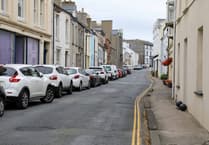People tend to be very familiar with their nearest city.
I suspect the Isle of Man might be an exception.
In the past fortnight, Belfast has seen rioting and violence that’s left nearly 100 police officers injured.
On Thursday, for the first time in six years in Northern Ireland, officers deployed a water cannon.
Countless petrol bombs have been thrown at armoured police vehicles and between a small number of people from different political communities.
A bus has been hijacked and set alight.
A large peace wall in the west of the city (a barrier separating hard-line unionist and nationalist areas) has also been targeted with a burning vehicle.
Disorder on this scale hasn’t been seen in Northern Ireland for several years.
The violence has brought international condemnation.
Last week, the White House called for calm and the restoration of peace on the streets.
This isn’t happening in some far-flung corner of the globe. It’s unfolding a few dozen miles from Peel, Port Erin and Kirk Michael.
This poses some, perhaps revealing, questions for people in the Isle of Man.
Do you know this is happening?
Do you think if President Biden’s administration was calling for an end to violence in Liverpool you’d be hearing more about it in the Manx media?
Would the island’s government react swiftly in sending messages of support and solidarity to their English neighbours?
Do you think that Manx politicians would be quick to praise Merseyside and promote the historic, important, links between both places?
If Lancashire was still emerging from a 30-year conflict that claimed thousands of lives, and paramilitaries still - today - existed within some communities there, would young Manx people be learning about this in school?
Ponder these questions over the coming days.
I’m a Manxman in Belfast. This is the closest city to where I’m from and I feel completely at home here.
When this place is on form, it’s unbeatable. As friendly, fun and humorous as any city you’ll find.
Growing up, this was where the ’Manx boat’ sailed to, and from where we welcomed thousands of visitors every summer.
Friends, teachers and colleagues were from these shores. Many others from Ireland, north and south, lived all across the Isle of Man.
We surely had, per head of population, one of the largest Irish communities outside the island of Ireland. That number might be greater now.
But this was never really reflected in day-to-day life.
Growing up through the last decade of The Troubles, I don’t recall much talk about what was happening to our western neighbours.
I don’t remember being taught anything about the historic Good Friday Agreement in 1998 or the horrific events in Omagh some months later.
I don’t recall any platform being provided for young people originally from Northern Ireland to talk about their experiences.
Never was any historical context provided to me as a young Manx person about why there was murder, destruction and political turmoil in my nearest city.
If those events were happening in Manchester, would this also have been the case?
My years living away, mostly in Northern Ireland but also England and a brief stint in America, has made me ponder the Manx psyche.
What shapes the island’s cultural mindset?
Language and terminology are interesting.
’Across’ and ’UK’ almost always mean England.
When Manx people refer to the ’North West’, they’re not referring to their own shores.
I’ve just referenced the island’s Irish community. Would it sound odd if I discussed the Isle of Man’s ’English community’?
Mostly, TV graphics and weather maps display the Isle of Man towards the top- left of the screen, showing the island’s proximity to Cumbria, Lancashire and Merseyside.
Rarely, if ever, is it framed to focus on the closeness of County Down and Dumfries & Galloway.
This is not an opinion or criticism. It’s an observation and other people will have different perspectives.
From the Down coast, I can see the Manx hills on the horizon. On a good day, they’re 18 minutes away by air.
It’s among the shortest commercial flights in the world.
I live on the island’s doorstep. Yet, a greater, different type, of distance remains.
Perhaps some of this has struck a chord with other Manx people living in cities like Glasgow, Edinburgh, Dublin or Cardiff.
The Isle of Man is a nation that politically, educationally and socially can be Anglo leaning. Often dominantly.
Why doesn’t it also look more in other directions?
The towering Harland & Wolff cranes in Belfast’s Titanic Quarter stand much closer to the island than Royal Albert Dock. You’d be forgiven for thinking this wasn’t the case. But it’s important to remember the next time you’re watching the news.
l Rick Faragher (pictured above) first moved to Northern Ireland in 2009 and has worked for BBC News NI since 2013.




